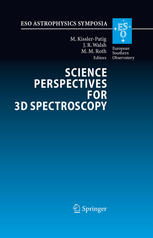

Most ebook files are in PDF format, so you can easily read them using various software such as Foxit Reader or directly on the Google Chrome browser.
Some ebook files are released by publishers in other formats such as .awz, .mobi, .epub, .fb2, etc. You may need to install specific software to read these formats on mobile/PC, such as Calibre.
Please read the tutorial at this link: https://ebookbell.com/faq
We offer FREE conversion to the popular formats you request; however, this may take some time. Therefore, right after payment, please email us, and we will try to provide the service as quickly as possible.
For some exceptional file formats or broken links (if any), please refrain from opening any disputes. Instead, email us first, and we will try to assist within a maximum of 6 hours.
EbookBell Team

4.3
58 reviews“You will hold in your hands the proceedings of the last conference ever on integral-?eld spectroscopy.” So the daring statement that we, organizers, made at the end of an extremely interesting and busy week of conference in October 2005. Indeed, the quality and diversity of the contributions in this book indicated that integral-?eld spectroscopy had evolved into a mature technique. Future books would not be dedicated to the technique as such but to the science achieved with ‘3D-spectroscopy,’ that is a dedicated book after thisone,assemblingscienceresultsacrosssomany?elds,isunlikelytoappear again (or have you seen a proceeding dedicated to ‘long-lit spectroscopy’ recently?). In a sense this is very encouraging. The idea of this conference was an o?springoftheResearchandTrainingNetwork(RTN)‘Euro3D’sponsoredby the European Commission. The goal of this network was to promote integr- ?eld spectroscopy from an technique for experts to a common user utility for astronomical research. When we ?rst talked about this conference the VLT, for example, was not yet equipped with any integral-?eld spectrograph. We were wondering whether anyone would actually attend the conference in 4 years’ time and would have anything to report upon. We were rewarded for our optimism and very positively surprised about the progress made in the years after that. A progress, of course, driven by theadventofsomanyintegral-?eldspectrographsaroundtheworld,installed on 4m to 8–10m class telescopes. Many of these instruments are referred to in the present book. Yet, this is explicitly not a book dedicated to technical issues,butfocusingonthescience.Thus,thenameoftheconference,Science Perspectives for 3D Spectroscopy.